Accuracy of Clinical Diagnosis and Sensitivity of the Laboratory Confirmation Method for Suspected Leptospirosis in Si Sa Ket Province
Main Article Content
Abstract
BACKGROUND: Leptospirosis is an important zoonotic disease with high morbidity and mortality in Thailand. With early diagnosis and prompt treatment, the mortality rate can be reduced. However, current diagnosis approaches still have many limitations, especially in Thailand, which relies mainly on laboratory results for confirmation of the disease.
OBJECTIVES: This study aimed to assess the accuracy and sensitivity of diagnosis for Leptospirosis among suspected cases in Si Sa Ket Province.
METHODS: This was a diagnostic research using a cross-sectional design, conducted by retrospective data collection. The target population comprised patients at the inpatient department, either at community hospitals or general hospitals in Si Sa Ket Province, who were suspected of having Leptospirosis and had specimens collected for laboratory analysis. Patients diagnosed with Leptospirosis included patients whose laboratory results were confirmed according to the diagnostic criteria of the Center for Disease Control and Prevention (CDC).
RESULTS: In this study, there were 329 samples suspected of having Leptospirosis during the study period, and a total of 228 were confirmed as contracting Leptospirosis. The accuracy was 69.3%. The sensitivity of Blood PCR, blood culture and MAT was 94.3, 6.5 and 3.6%, respectively. The Leptospira interrogans serovar Shermani was the most common serovar, followed by Leptospira interrogans serovar Australis among all 18 serovars found.
CONCLUSIONS: Accuracy concerning the diagnosis of Leptospirosis among suspected cases in Si Sa Ket Province was high (69.3%). Providing immediate treatment after suspecting Leptospirosis, without waiting for confirmation from laboratory results, should be performed to reduce the mortality rate as well as complications.
Thaiclinicaltrials.org number, TCTR20220510007
Article Details

This work is licensed under a Creative Commons Attribution-NonCommercial-NoDerivatives 4.0 International License.
References
Faine S. Guidelines for the control of leptospirosis. Geneva : World Health Organizaion; 1982.
Pappas G, Papadimitriou P, Siozopoulou V, Christou L, Akritidis N. The globalization of leptospirosis: worldwide incidence trends. Int J Infect Dis 2008;12:351-7.
World Health Organization. Report of the first meeting of the leptospirosis burden epidemiology reference group; 2010 [Internet]. WHO. 2010[cited 2017 Jan 5]. Available from: http://apps.who.int/iris/bitstream/handle/10665/44382/9789241599894_eng.pdf;sessionid=3480EAC0B75EF6552B7739FC04C2771F?sequence=1
Vijayachari P, Sugunan AP, Shriram AN. Leptospirosis: an emerging global public health problem. J Biosci 2008;33:557-69.
Musso D, La Scola B. Laboratory diagnosis of leptospirosis: a challenge. J Microbiol Immunol Infect 2013;46:245-52.
Bandara K, Weerasekera MM, Gunasekara C, Ranasinghe N, Marasinghe C, Fernando N. Utility of modified Faine's criteria in diagnosis of leptospirosis. BMC Infect Dis [Internet].2016 [ cited 2021 Mar 10];16(1):446. Available from: https://bmcinfectdis.biomedcentral.com/track/pdf/10.1186/s12879-016-1791-9.pdf
Sukmark T, Lumlertgul N, Peerapornratana S, Khositrangsikun K, Tungsanga K, Sitprija V, et al. Thai-Lepto-on-admission probability (THAI-LEPTO) score as an early tool for initial diagnosis of leptospirosis: result from Thai-Lepto AKI study group. PLoS Negl Trop Dis [Internet]. 2018 [2020 Apr 20];12(3):e0006319. Available from: https://www.ncbi.nlm.nih.gov/pmc/articles/PMC5875898/pdf/pntd.0006319.pdf
Picardeau M, Bertherat E, Jancloes M, Skouloudis AN, Durski K, Hartskeerl RA. Rapid tests for diagnosis of leptospirosis: current tools and emerging technologies. Diagn Microbiol Infect Dis 2014;78:1-8.
Ramachandran A, Shanthi M, Sekar U. Detection of bla CTX-M extended spectrum beta-lactamase producing salmonella enterica serotype typhi in a Tertiary Care Centre. J Clin Diagn Res [Internet]. 2017 [cited 2020 Nov 10];11(9):DC21-DC24. Available from: https://www.ncbi.nlm.nih.gov/pmc/articles/PMC4378738/pdf/jcdr-9-DC21.pdf
Jipa RE, Andreescu N, Manea E, Diaconu S, Niculescu D, Antonică D, et al. Clinical and laboratory characteristics in leptospirosis. BMC Infect Dis [Internet]. 2014 [cited 2020 Apr 20];14(Suppl 7): P29. Available from: http://www.biomedcentral.com/1471-2334/14/S7/P29
Wuthiekanun V, Sirisukkarn N, Daengsupa P, Sakaraserane P, Sangkakam A, Chierakul W, et al. Clinical diagnosis and geographic distribution of leptospirosis, Thailand. Emerg Infect Dis 2007;13:124-6.
Anual Epidemiology Surveillance Report 2015 : leptospirosis [Internet]. Department of Disease Control, Thailand. 2015 [cited 2017 Apr 5]; Available from: https://www.ecdc.europa.eu/sites/default/files/documents/AER_for_2015-leptospirosis.pdf
Si Sa Ket Provincial Health Office. Provincial disease passive surveillance report; Leptospirosis. Si Sa Ket: Si Sa Ket Provincial Health Office; 2017.
National Notifiable Diseases Surveillance System (NNDSS). Leptospirosis (Leptospira interrogans) 2013 Case Definition [Internet]. 2013 [cited 14 Oct 2019]. Available from: https://ndc.services.cdc.gov/case-definitions/leptospirosis-2013/
Phimda K, Hoontrakul S, Suttinont C, Chareonwat S, Losuwanaluk K, Chueasuwanchai S, et al. Doxycycline versus azithromycin for treatment of leptospirosis and scrub typhus. Antimicrob Agents Chemother 2007;51:3259-63.
Thipmontree W, Suputtamongkol Y, Tantibhedhyangkul W, Suttinont C, Wongswat E, Silpasakorn S. Human leptospirosis trends: northeast Thailand, 2001-2012. Int J Environ Res Public Health 2014;11:8542-51.
Tangkanakul W, Smits HL, Jatanasen S, Ashford DA. Leptospirosis: an emerging health problem in Thailand. Southeast Asian J Trop Med Public Health 2005;36:281-8.
J Day NP. Leptospirosis. In: Cohen J, Powderly WG, Opal SM; editor. Infectious diseases. 4 th ed. China: Elsevier; 2017. p. 1102 1104.e1.
Hinjoy S. Epidemiology of eptospirosis from Thai National Disease Surveillance System, 2003-2012. OSIR 2014; 7(2):1-5.
Suputtamongkol Y, Pongtavornpinyo W, Lubell Y, Suttinont C, Hoontrakul S, Phimda K, et al. Strategies for diagnosis and treatment of suspected leptospirosis: a cost-benefit analysis. PLoS Negl Trop Dis [Internet]. 2010 [cited 2020 Oct 14].;4(2):e610. Available from: https://journals.plos.org/plosntds/article/file?id=10.1371/journal.pntd.0000610&type=printable

